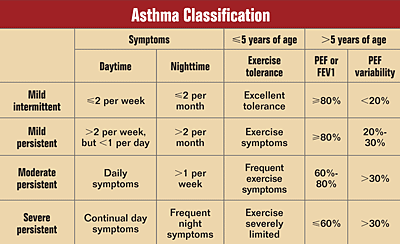Strategies being investigated to decrease incidence of pediatric asthma
When dealing with asthma, it is essential to obtain a good clinical history to determine the patient’s symptoms.
NEW YORK — Physicians should obtain a detailed history and determine risk factors when assessing patients at risk for developing pediatric asthma.
Julie Wang, MD, assistant professor of Pediatrics at Mount Sinai School of Medicine, Mount Sinai Medical Center in New York, said that asthma can be defined as chronic inflammatory disorder characterized by:
- reversible airway obstruction
- airway hyperresponsiveness
- mucus secretion
- airway remodeling.

When dealing with patients with asthma, it is essential to obtain a good clinical history to determine the patient’s symptoms. Wang suggested looking at some key symptoms while taking a patient’s clinical history, including frequency, intensity and pattern of symptoms, sleep disturbance, frequency of exacerbations and interim health care use, frequency of rescue bronchodilator medication use and activity limitations.
“Obviously, it would be impractical to go biopsy every patient ... Therefore, we must rely on the clinical history and a physical,” Wang said at the 19th Annual Infectious Diseases in Children Symposium, held here. “Although nearly half of children experience wheezing at some point in early life, not every child who wheezes will develop asthma. Therefore, obtaining a detailed history and an assessment of risk factors for asthma is essential.”

Adapted from Expert Panel Report: Guidelines for the Diagnosis and Management of Asthma Update on Selected Topics 2002. National Asthma Education and Prevention Program. June 2003. www.nhlbi.nih.gov/guidelines/asthma/index.htm
Asthma criteria
If the patient is a frequent wheezer – four or more episodes in any year within the first three years of life – it is helpful to use the asthma predictive index (API) to diagnose asthma. The API consists of two categories: major criteria and minor criteria. A patient must have at least one major criterion and at least two minor criteria in order to be categorized as having asthma.
The major criteria include a parental history of asthma, doctor-diagnosed atopic dermatitis and allergic sensitization to at least one aeroallergen. The minor criteria include wheezing unrelated to colds, eosinophils at more than 4% and allergic sensitization to milk, eggs or peanuts.
“The asthma predictive index is a very useful tool to determine whether a child has an elevated risk for developing asthma,” Wang said. “If a patient does satisfy these criteria, their risk for developing asthma is approximately 50%. However, if they do not fulfill these criteria, their risk for developing asthma is less than 10%.”
Wang also mentioned some diagnoses to include in the differential. Ruling out infections like bronchiolitis, or sinusitis, gastroesophageal reflux, cystic fibrosis, foreign body aspiration, vocal cord dysfunction, bronchopulmonary dysplasia, or congenital anomalies with airway impingement can assist with the diagnosis of asthma. Atopic history can also be a predictor of asthma.
Objective measures, such as spirometry, peak flow, bronchial provocation and forced oscillation are also good tools for assessing asthma.
“As you know, asthma severity can be classified as four levels depending on the asthma symptoms, as well as objective measures including FEV1 and peak flow. The four categories include mild-intermittent, mild-persistent, moderate-persistent and severe-persistent asthma [see chart],” Wang said.
Life-threatening asthma has many risk factors that physicians should be looking for when taking a patient’s history and/or list of symptoms. These risk factors include severe asthma, poor control of symptoms or noncompliance, current use or recent withdrawal from systemic corticosteroids, previous near-fatal asthma, hospitalization or emergency department visits in the past year, atopy, and the failure to recognize the severity of the patient’s asthma
“Approximately 5,000 asthma-related deaths occur in the United States each year. Risk factors for life-threatening asthma are, therefore, important to identify,” Wang said.
Treatment
Understanding the management options available for asthma is critical because adequate treatment allows patients to continue normal childhood activities, according to Wang.
There are two types of asthma to determine treatment: well-controlled asthma and completely controlled asthma.
A patient has “well-controlled asthma” when they have:
- Two asthma symptoms per week or less
- Two rescue bronchodilator uses per week or less
- No nighttime symptoms or early morning awakenings
- No limitations in work, school or exercise
- Normal or personal best peak flow or FEV1
“Continual reassessment is important. If a child is well-controlled then medications can either be stepped-down or left alone,” Wang said. “However, if the patient’s asthma is not controlled well then stepping-up or changing the medications would be required.”
If a patient’s asthma is well controlled, the physician should determine whether to step-down the medication or have no change in medication. But if a patient’s asthma is poorly controlled, the physician should determine whether to step-up the patient’s medication or change the medication.
For the poorly controlled patient, physicians should consider inadequate medications, exposure to triggers, drug interactions or possibly having the wrong diagnosis.
Asthma prevention
Studies have shown that early use of steroids does not alter the progression to asthma but can help control asthma symptoms. Immunotherapy may also be able to stop allergic sensitization and, thus, progression to asthma.
Allergen avoidance measures have proven inconclusive, but there are some precautions to take. For dust mite allergens, Wang suggested using allergen impermeable encasements for pillows and mattresses.
Even though these are good starting points, more prevention is needed. Preventive strategies are being investigated in hopes of modifying risk factors and decreasing the incidence of pediatric asthma, according to Wang. – by Leanor A. Pigliacelli
For more information:
- Guilbert TW, Morgan WJ, Zeiger RS, et al. Long-term inhaled corticosteroids in preschool children at high risk for asthma. N Engl J Med. 2006;354:1985-1997.
- Kemp JP. Advances in the management of pediatric asthma: a review of recent FDA drug approvals and label updates. J Asthma. 2005;42:615-622.
- Martignon G, Oryszczyn MP, Annesi-Maesano I. Does childhood immunization against infectious diseases protect from the development of atopic disease? Pediatr Allergy Immunol. 2005;16:193-200.
- Guilbert TW, Morgan WJ, Zeiger RS, et al. Atopic characteristics of children with recurrent wheezing at high risk for the development of childhood asthma. J Allergy Clin Immunol. 2004;114:1282-1287.
- Passalacqua G, Ciprandi G, Pasquali M, et al. An update on the asthma-rhinitis link. Curr Opin Allergy Clin Immunol. 2004;4:177-183.
- Passalacqua G, Lombardi C, Canonica GW. Sublingual immunotherapy: an update. Curr Opin Allergy Clin Immunol. 2004;4:31-36.
- Moller C, Dreborg S, Ferdousi HA, et al. Pollen immunotherapy reduces the development of asthma in children with seasonal rhinoconjunctivitis (the PAT-study). J Allergy Clin Immunol. 2002;109:251-256.
- Illi S, von Mutius E, Lau S, et al. The pattern of atopic sensitization is associated with the development of asthma in childhood. J Allergy Clin Immunol. 2001;108:709-714.
- Kalliomaki M, Salminen S, Arvilommi H, et al. Probiotics in primary prevention of atopic disease: a randomised placebo-controlled trial. Lancet. 2001;357:1076-1079.
- Castro-Rodriguez JA, Holberg CJ, Wright AL, et al. A clinical index to define risk of asthma in young children with recurrent wheezing. Am J Respir Crit Care Med. 2000;162:1403-1406.
- Martinez FD, Wright AL, Taussig LM, et al. Asthma and wheezing in the first six years of life. The Group Health Medical Associates. N Engl J Med. 1995;332:133-138.
